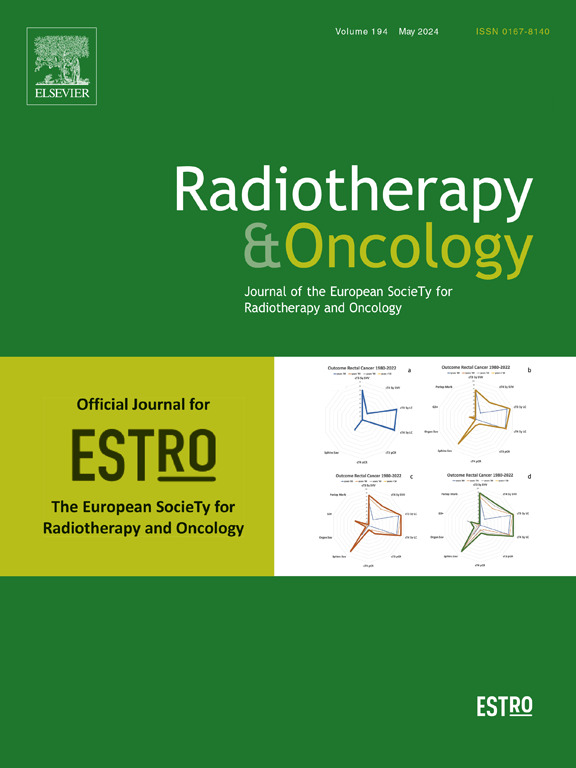SBRT治疗肾细胞癌后的反应评估和肿瘤缩小模式。
IF 4.9
1区 医学
Q1 ONCOLOGY
引用次数: 0
摘要
目的:尽管立体定向体放疗(SBRT)在肾细胞癌(RCC)中的应用前景广阔,但评估肿瘤对SBRT反应的最佳时间和方法尚不清楚。我们的目的是比较实体肿瘤反应评价标准(RECIST) 1.1和修订后的RECIST (mRECIST)在RCC反应评估中的效用,并阐明sbrt后肿瘤缩小模式。材料和方法:我们回顾性研究了2016年11月至2021年12月在我院接受SBRT治疗的RCC患者。使用RECIST 1.1和mRECIST评估基线和随访图像。采用上述两个标准评估局部控制与肿瘤反应状态之间的关联,并进行里程碑式分析。结果:91例原发性或转移性肾癌患者共103例。客观缓解率(orr)更高,在每个时间段内,mRECIST评估假性进展的频率低于RECIST 1.1。使用RECIST 1.1的骨病变中位收缩率远低于使用mRECIST (-0.8 vs -1.7 cm/年)。根据这两个标准,在sbrt后9-12 个月,ORR趋于稳定。在9-12 个月肿瘤反应的患者使用mRECIST后,内野复发的概率较低(P = 0.047),而使用RECIST 1.1时没有观察到这一点(P = 0.061)。结论:在接受SBRT治疗的RCC患者中,与RECIST 1.1相比,mRECIST的疗效评估更早、更明显。sbrt后9 - 12个月可作为mRECIST评估肿瘤反应的早期里程碑。本文章由计算机程序翻译,如有差异,请以英文原文为准。
Response evaluation and tumor shrinkage pattern post-SBRT for renal cell carcinoma
Purpose
Despite the promising application of stereotactic body radiotherapy (SBRT) in renal cell carcinoma (RCC), the optimal time and method for assessing tumor responses to SBRT remain unclear. We aimed to compare the utility of Response Evaluation Criteria in Solid Tumors (RECIST) 1.1 and modified RECIST (mRECIST) in RCC response assessment and clarify the tumor shrinkage pattern post-SBRT.
Materials and methods
We retrospectively studied patients with RCC treated with SBRT at our institution between November 2016 and December 2021. Baseline and follow-up images were evaluated using RECIST 1.1 and mRECIST. Landmark analyses were conducted to assess the association between local control and tumor response status evaluated using the above two criteria.
Results
Ninety-one RCC patients with 103 primary or metastatic lesions were included. Objective response rates (ORRs) were higher and pseudoprogression was less commonly assessed by mRECIST than by RECIST 1.1 within each time period. The median shrinkage rate of bone lesions was much lower using RECIST 1.1 than that using mRECIST (−0.8 vs −1.7 cm/year). According to both criteria, the ORR tended to be stable on the 9–12 months post-SBRT. Patients with a tumor response at 9–12 months had a lower probability of infield recurrence using mRECIST (P = 0.047), this was not observed using RECIST 1.1 (P = 0.061).
Conclusion
mRECIST results in an earlier and more pronounced response evaluation compared to RECIST 1.1 in patients with RCC treated with SBRT. Nine to twelve months post-SBRT may serve as an early landmark for tumor response evaluation by mRECIST.
求助全文
通过发布文献求助,成功后即可免费获取论文全文。
去求助
来源期刊

Radiotherapy and Oncology
医学-核医学
CiteScore
10.30
自引率
10.50%
发文量
2445
审稿时长
45 days
期刊介绍:
Radiotherapy and Oncology publishes papers describing original research as well as review articles. It covers areas of interest relating to radiation oncology. This includes: clinical radiotherapy, combined modality treatment, translational studies, epidemiological outcomes, imaging, dosimetry, and radiation therapy planning, experimental work in radiobiology, chemobiology, hyperthermia and tumour biology, as well as data science in radiation oncology and physics aspects relevant to oncology.Papers on more general aspects of interest to the radiation oncologist including chemotherapy, surgery and immunology are also published.
 求助内容:
求助内容: 应助结果提醒方式:
应助结果提醒方式:


